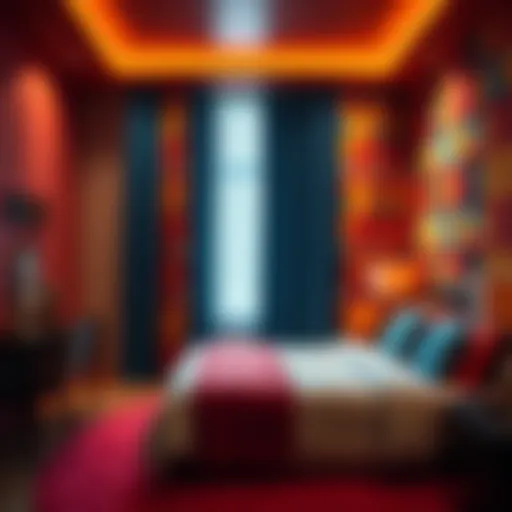Choosing the Perfect Fencing for Your Garden Space
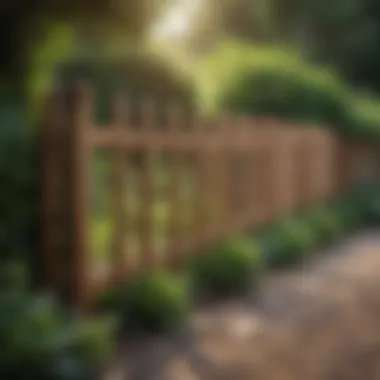

Intro
Selecting fencing for your garden plays a crucial role in its overall design and functionality. It can establish boundary lines, provide privacy, and enhance the aesthetic value of the outdoor space. In the world of landscape architecture, the right choice goes beyond mere looks; it affects how a space is utilized and experienced. This article aims to shed light on various options available in garden fencing by examining materials, styles, and the associated costs.
A properly chosen fence can enhance a garden's identity. Preferences differ based on regional culture, personal tastes, and practicality. Understanding each aspect leads to better decisions. Information on materials like wood, vinyl, or metal will be dissected here, alongside stylistic choices ranging from classic to contemporary.
With this article, the reader will grasp the interconnectedness of functionality and design. Making informed decisions becomes simpler.
Outdoor Decor Ideas
Fencing in a garden can be a statement piece that ties everything together. It serves as not only a boundary but also an integral part of outdoor decor. Whether you prefer a rustic look or a modern aesthetic, fencing options are diverse and tailored to personal flair. Here are several inspirations to consider:
Seasonal Inspirations
A garden evolves through the seasons, and the chosen fencing can complement these changes. For spring, dainty trellises can showcase climbing flowers, and autumn invites wooden fences that can hold vibrant, foliage-rich vines. Think about incorporating seasonal decorations that align with the style of the fence.
Furniture Selection
When selecting garden furniture, it is beneficial to ensure consistency in the themes as the fencing. For example, if you choose a traditional cottage-style fence, furniture made of natural wood aligns better than modern steel models.
Decorative Lighting
Various lighting installations can highlight the unique character of your fencing. Edged lighting along fences enhances pathways and demonstrates safe passages while adding visual charm during evening gatherings. Consider hidden fixtures to maintain a seamless design.
Plant Arrangements
Fences serve as natural backdrops for a purposeful plant arrangement. Climbers that adorn fencing, like jasmine or wisteria, elevate both privacy and aesthetics as they enhance visual appeal through vertical layers of greenery. Selecting appropriate plants enhances the essence of your garden in conjunction with your fencing choice.
Hardscaping Solutions
Utilizing hardscape materials like stone or brick alongside fencing can elevate a garden's sophistication. Pathways going through or near fencing methods interplay positively with surrounding hardscaping elements, offering a coherent environment that balances both organic and structured attributes.
Sustainable Practices
Sustainability is vital for gardening trends today. Select eco-friendly materials that align with your green practices and aesthetic sensibilities. Fencing made from recycled products or sustainably sourced timber resonates environmentally-conscious values while promoting natural beauty.
A garden should not only be a personal retreat but also the reflection of one's tastes and principles.
Understanding the Purpose of Garden Fencing
Garden fencing plays a crucial role in enhancing outdoor spaces. Its primary functions can be categorized as privacy, security, and aesthetics. For homeowners, fencing serves as more than just a barrier; it defines the structure and boundaries of the garden.
Defining Privacy and Security Needs
Establishing privacy and security begins with understanding your specific requirements. High garden fences can act as deterrents against intruders and provide peace of mind. If you prioritize solitude in your outdoor retreat, think about using tall wooden or vinyl fences. These offer reliable screening from nosy neighbors while allowing ample sunlight.
Moreover, consider potential wildlife problems. A tall, durable fence can prevent deer or rabbits from invading your garden and consuming tender plants.
- Assess your surroundings. Evaluate neighboring properties and access points for your yard. If your garden faces a busy street or public space, opt for solid fencing to create a serene environment.
- Maintain a balance between aesthetics and security. Consider incorporating elements like gates that blend with the fencing materials, creating an inviting yet secure entrance.
Aesthetic Considerations
Aesthetic value is integral to any fencing decision. Think about the architectural style of your home and your landscaping motif. Fencing comes in various materials, colors, and designs that can enhance your garden's visual appeal. For example, a white picket fence aligns with classic American charm, while sleek metal panels might complement modern designs.
Choosing the right style is essential for a coherent look. A pleasing visual element fosters warmth, often making outdoor areas more enjoyable. As you select furniture and decor, remember that cohesive color schemes and materials benefits overall ambiance.
- Activities take place in gardens, so an attractive fence increases window views and sets the tone for gatherings.
- Incorporate varied textures. Mixing materials such as wood and metal can create depth and interest.
Common Materials for Garden Fencing
When considering garden fencing, the material you choose holds substantial importance. Each type of material offers different features, aesthetics, and levels of durability. Understanding these options allows for a more informed choice, optimizing both the visual appeal and functional requirements of your garden. Let’s take a closer examine the common materials you may consider for this pivotal garden element.
Wood Fencing
Types of Wood
Wooden fencing typically comes in several types. Among the most recognizable are cedar, pine, and redwood, each with prevaricate characteristics. Cedar is often chosen for its natural resistance to decay. Pine, though usually more cost-effective, may require additional treatment for longevity. Redwood has a charming aesthetic but comes with a higher purchase cost. The specific nature of these woods plays a crucial enhancement role to your garden's overall charm. Properly selected wood types offer fantastic longevity and adaptability to your gardening style.
Durability and Maintenance
Durability in wood fencing predominantly relies on the type of wood installed. A well-maintained wooden fence can last over a decade. Though attractive, it typically needs regular upkeep, requiring stains or sealants that combat the effects of weather. Understanding these maintenance requirments brings awareness to the possibility of recurrent costs and workloads. Therefore, one must balance the attractiveness of wood with the effort and potential expense related to its upkeep.
Vinyl Fencing
Benefits of Vinyl
Vinyl fencing steadily rises in popularity due to its inherent advantages. As a synthetic material, it resists the traditional decay seen in other materials such as wood, providing an appealing and long-lasting option. One key attribute of vinyl is its ease of cleaning, which greatly reduces the overall maintenance load. Can be shaped into various styles, vinyl succesfully combines functionality with modern aesthetics.
Long-term Cost Implications
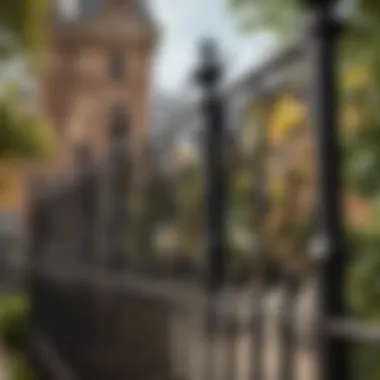

Vinyl fencing generally comes with slightly higher initial costs. Nevertheless, its durability results in lower repair and replacement rates over time. Homeowners investing in vinyl will likely save expenses on maintenance compared to wood or metal alternatives. These long-term considerations play a significant part in financial estimating when evaluating fencing options for your outdoor area.
Metal Fencing
Types of Metal
Steel, aluminum, and wrought iron made up the primary metal types utilized in fencing. Steel may offer superior security, while aluminum presents rust-proof benefits. Wrought iron, although aesthetically pleasing, often exceeds others in terms of cost. Each type contributes uniquely around stability and visual elegance, driving the decision-making process around ensuring fenc's durability.
Design Versatility
Metal fencing enjoys significant design versatility. Available in countless shapes and sizes, homeowners have almost limitless opportunities to create a distinct look. This adjustability lends itself well to various architectural themes present in urban and suburban environments alike. Its adaptability molds flawlessly into diverse landscaping schemes, providing a practical yet elegant option for fencing needs.
Natural Barriers
Hedges and Shrubs
Choosing natural barriers like hedges and shrubs introduces organic elements to garden design. Varieties available span across vast colors and textures. Lavender and boxwood are regularly employed choices that create enchanting boundaries while allowing for privacy. Hedges also possess a friendly bias towards nature, attracting pleasant fauna into gardens.
Environmental Benefits
Incorporating natural barriers can yield substantial environmental advantages. Unlike synthetic methods, they inclusively support local ecosystems, offering habitats for beneficial animals. By absorbing carbon dioxide with resilience, natural structures play a complementary role in overall ecological balance. Ultimately, prioritizing this approach pays homage to environmental efficiency in baoth garden design and biodiversity advocacy.
Styles of Garden Fencing
Choosing the right style of garden fencing plays a crucial role in how a garden is perceived and enjoyed. The style influences not just the visual appeal, but also the overall functionality of the garden. Various styles cater to diverse preferences and needs, ranging from traditional to modern aesthetics. Each fencing style carries its own significance in the context of the garden's purpose, the surrounding environment, and the owner's personal taste. Therefore, understanding the available styles is essential for making an informed choice that aligns with one's home and landscape.
Traditional Wooden Fences
Pickett Fences
Pickett fences generally are known for their distinctive and open design, which allows visibility while maintaining a boundary. This aspect appeals to those seeking a balance between privacy and transparency. A key characteristic of pickett fences is the vertical planks set with gaps between them. This ensures that they are visible from a distance. Their traditional appearance can greatly enhance the beauty of a nicely landscaped area.
A defining feature is their adaptability. They can suit different styles of homes, from quaint cottages to more contemporary houses. It’s easy to customize with various heights and colors, making them a flexible choice. Nonetheless, they may not offer sufficient security compared to more solid barriers, and maintenance demands could also be higher depending on the wood type used.
Board-on-Board Fences
The design of board-on-board fences consists of overlapping vertical boards. This ensures complete privacy, while still allowing for some airflow. This characteristic makes them a popular choice for many homeowners aiming to protect their outdoor space. Their construction allows visibility from both sides when they are placed aesthetically, giving them a significant edge in additions to curb appeal.
Moreover, they are also reliable for sound dampening—helpful in urban settings where noise is an issue. One unique feature is the ability to alternate the boards, creating a pattern that can be visually striking. However, they could require more materials and result in a higher installation cost compared to simpler fence types.
Modern Designs
Sleek Metal Panels
When it comes to modern fencing, sleek metal panels have gained traction due to their minimalistic feel and substantial durability. Metal allows for creative expressions seen in geometric patterns, which can modernize the garden's design effectively. The defining quality of these panels is their maintenance-free nature—meaning homeowners can enjoy stylish fencing without frequent upkeep.
Sleek metal fences also provide excellent security. They are robust against weather elements and tend to have a lifespan exceeding wooden alternatives. However, one must consider the style of the home to ensure these panels will harmonize; sometimes they may indeed come off as overly clinical or rigid for softer landscapes.
Minimalist Vinyl Options
Minimalistic vinyl options complement contemporary outdoor areas with their clean and uncomplicated look. These fences are widely appreciated for functionality and no-maintenance existence. One key aspect is their resistance to rot or insect damage, no matter the weather condition. Consequently, this can save homeowners both time and money in the long run.
An important characteristic is their flexibility in design; different styles are available, and color choices expand their appeal. Yet, depending on the quality of vinyl selected, it could carry a less premium look compared to elegant wood or metal choices- especially for high-end presentations. This is crucial for homeowners who may prioritize aesthetics equally alongside functionality.
Decorative Fencing
Lattice Fences
Lattice fences often serve a decorative purpose within gardens. Typically, they consist of wooden slats arranged in a crisscross pattern. This type provides a visual through-line, keeping some connection to the outside while allowing for climbing plants to flourish. They are compatible with various styles of filing in the atmosphere ranging from romantic gardens to minimalist spaces.
The unique feature lies in how easily they include integrated greenery, allowing nature to intertwine with man-made structures. Although they add beauty, special attention should be paid in their placement, as they generally lack significant privacy. Over time, they also require effort in maintenance to preserve their appearance and correctness.
Artistic Designs
Artistic fencing brings a distinctive charm to gardens that may otherwise remain unnoticed. Their unique feature depends on custom designs, incorporating non-standard elements, shapes, or patterns created by skilled artisans. This uniqueness caters to an array of preferences, whether it's rustic charm or contemporary edge.
The fundamental characteristic of artistic fencing is how confidently they can lift a typical space’s aesthetic, transforming plain gardens into artful experiences. It's significant for owners who value individualism in their outdoor space. However, the higher price points often boost costs, particularly if specialized craftsmanship is involved. Striking a precise balance between intentional beauty and practical function becomes key.
When selecting a style of garden fencing, consider how each option complements your garden's overall aesthetics and functionality.
Cost Considerations
When selecting fencing for your garden, cost is a principal consideration that can greatly influence your decision. The expenses involved can range from materials to labor, affecting not just the immediate outlay but also long-term financial implications. It is vital to underline how your choices can meet your aesthetic desires while remaining within your budget. Substantial investments can lead to higher durability and fewer replacements, impacting the overall economics of garden fencing.
Budget-Friendly Options
DIY Fencing
DIY fencing is an appealing choice for many individuals looking to cut costs. It allows homeowners to engage actively in shaping their outdoor spaces while also saving on labor costs typically associated with installation. One key characteristic of DIY fencing is the control it gives to the homeowner over design and execution. You can customize the fence to reflect personal style without the hefty price tag of hiring professionals.
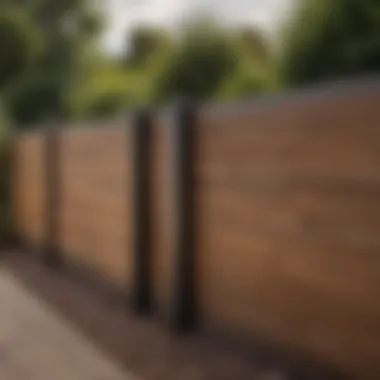

However, DIY projects require a level of skill and investment in tools, which some may find demanding over time. There's a mix of satisfaction and challenge in building your own fence, but it can lead to potential installation errors if not done correctly. On the whole, many find DIY approaches to be a beneficial way of achieving a quality outcome without overspending.
Low-Cost Materials
Low-cost materials present another economical avenue for choosing garden fencing. Options like chain-link or pressure-treated pine can be budget-friendly while still providing necessary functionality. The key feature of these materials is their accessibility and affordability, making them attractive choices for those with limited funds.
The primary advantage of using low-cost materials is the immediate reduction in expenses. You may avoid high-quality or custom options at the outset, but it is important to keep in mind that long-term durability can suffer. Choosing low-cost materials means you may need to replace them sooner than high-end options, or face additional maintenance down the line.
Long-Term Investments
Reassessing Quality vs.
Price
Evaluating quality against the price of garden fencing allows you to make more informed decisions. Often, a higher initial cost can yield better durability and aesthetics over time. This creates a scenario where higher-quality materials provide a better return on investment through longevity compared to less costly alternatives.
This analysis promotes a richer understanding of long-term stewardship of the garden. For instance, investing more upfront on materials like cedar or wrought iron might seem extravagant initially, but their long life aids in mitigating costs incurred through replacements, adding overall value to your investment.
Potential Increase in Property Value
Another worthwhile consideration in choosing garden fencing focuses on its impact on property value. Installing appealing and functional fencing can contribute positively to market perception and make your home more desirable. This characteristic becomes especially crucial in upscale market categories where aesthetics and presentation can greatly influence buyers.
While the goal is not only to ensure security and privacy, potential boundary enhancements steps up your property’s attractiveness. A well-chosen fence also reflects on the overall garden aesthetics, making way for a strategic investment should you decide to sell.
Investing in quality isn't simply an expense, it transforms a house into a home and reflects the owner's care for their space and values.
Cost considerations play a pivotal role in selecting the right garden fence. Balancing immediate savings from budget options and the long-term benefits of sturdier materials is critical. Making informed choices ensures your investment aligns perfectly with your desires and budgetary constraints.
Local Regulations and Permits
Local regulations and permits play a crucial role when selecting fencing for your garden. Understanding these legal requirements ensures that your fencing decisions align with local laws, ultimately helping you avoid unnecessary fines or the need to take the fence down after installation.
Regulations often dictate the height, materials, and even styles of fencing that can be installed in residential areas. Ignoring these laws can lead to conflicts with neighbors, which brings about additional social stress. Therefore, ensuring your choices are compliant can contribute to peaceful living.
Some common considerations involve:
- Proximity to property lines: There are often regulations around how close a fence can be placed to your boundary.
- Height restrictions: Many communities allow only certain heights for fencing in front or back yards.
- Visual aesthetics: Some areas have strict guidelines on how fences must look to preserve neighborhood uniformity or national heritage.
Thoroughly researching the local rules can save time and resources. Engaging local authorities or community association websites may reveal pertinent zoning regulations that may not be readily apparent.
Understanding Zoning Laws
Zoning laws establish the framework for how areas within a community are used. These laws often stipulate specifics related to fencing, such as maximum height or appropriate materials.
In urban settings, particularly in luxury neighborhoods, meticulous compliance with zoning can differentiate optimal choices from mistakes. There could also be restrictions based on the nature of a home in historical areas or developments.
It's advisable to:
- Review local government website for zoning regulations, frequently posted under ordinance titles.
- Consider submitting a question directly if clarity is needed regarding specifics.
This initial approach sets a reliable foundation on your path.
Obtaining Necessary Permits
Most municipalities require homeowners to obtain a permit before erecting a fence. This delivers benefits for public safety as well as community planning.
Gather the required details for permits typically involves:
- Submitting property maps showing precise boundary lines.
- Documents outlining your proposed fencing materials and designs.
Often, some councils may require applicants to wait for a scheduled review of imminent installations. This can include the possibility of needing neighbor notifications or adjustments based on public feedback.
Securing a permitting process may feel administratively burdensome but following through ensures compliance, opening channels for appealing fencing choices without unexpected repercussions. Documentation pertaining to fence location and height can serve as effective backup measures in case disputes arise.
By following these protocols, you can avoid potential issues related to zoning violations or community complaints, leading to a seamless installation process.
Following local regulations and acquiring the necessary permits is pivotal in the overall fencing decision and installation journey. Your property will effectively balance your aesthetic desires with compliance—a practical yet elegant solution.
Installation Considerations
When choosing the right fencing for your garden, installation considerations play a major role. The way a fence is installed influences not just its durability, but also its appearance and overall effectiveness. Carefully selecting between professional installation and DIY installation can help ensure that your choice suits both aesthetic and functional needs effectively. An optimal installation will enhance the privacy, security, and attractiveness of your garden.
Professional Installation Advantages
Opting for a professional installation can save you time and stress. Expert installers have the skills and tools required for the job, leading to a more polished final result. Not only can this approach ensure precision, but it also allows for the seamless alignment of materials and effective management of unpredictable landscaping conditions. Professionals can often recommend specific methods tailored to each fencing type.
Someprimary advantages include:
- Experience: Trained professionals know best practices and have dealt with a variety of landscape challenges before.
- Quality Ensure: Experts ensure that all aspects, such as protection from weather elements, are accounted for during installation.
- Warranty Services: Many professional services offer warranties on their work, providing a safety net for the future.
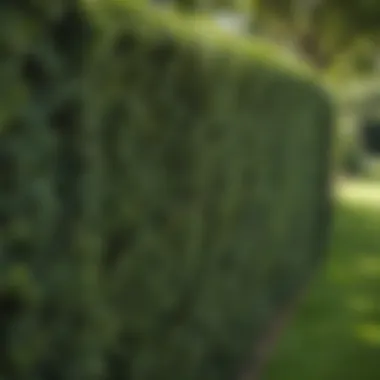

All garden fencing installation requires planning. Missteps can result in higher costs, broken aesthetics, or even unsuitable fencing materials for your intended purpose. Therefore, seeking professional advice is often the wisest choice.
DIY Installation Tips
Some individuals may opt for a DIY installation for several reasons including cost reduction and the enjoyment of tackling projects. A DIY approach can indeed be fulfilling; however, careful planning is necessary. Some considerations to keep in mind are:
- Tools Preparation: Gather necessary tools such as a level, post hole digger, and saw.
- Permits and Guidelines: Investigate local regulations to ensure you comply with zoning laws.
- Space Measurement: Accurate measuring is essential not only for aesthetics but to comply with property lines.
- Material Choice: Select fencing materials that are manageable and suited for the DIY effort. Simper panels can greatly reduce difficulty.
Additionally, leverage online resources and community forums for guidance. Many have shared knowledge and experiences that may prove invaluable. Engaging with platforms like reddit.com can give you real-time feedback.
A concise project plan, alongside the proper tools, can make the DIY process easier and more successful. Choosing the right approach to installation ultimately lays the foundation for a garden fence that meets aesthetic and functional purposes.
Maintenance and Care
Maintaining your garden fencing is crucial for its longevity and visual appeal. Regular upkeep not only prevents the deterioration of fence materials but also ensures the aesthetics of your landscape are preserved. A well-maintained fence enhances the overall elegance of your garden, often elevating property value.
Investment in quality fencing can yield significant benefits when proper care is given. Moreover, regular maintenance can reveal potential issues early, which allows for cost-effective repairs and prolongs the life of the fencing.
Routine Maintenance Practices
Implementing simple routine practices can vastly improve the lifespan of your garden fence. Each material requires its own attention:
- Wood Fencing: Inspect for rot and signs of pest infestation. Regularly treat it with protective sealants or stains.
- Vinyl Fencing: Clean dirt and grime using mild detergent and water this will keep its shiny and clean look.
- Metal Fencing: Look for rust spots, especially in humid areas. Address weatherproofing paint when needed to protect against corrosion.
- Natural Barriers: Regularly trim hedges or shrubs to prevent overgrowth which can damage fencing. This also aids in maintaining their health.
Consistency in these practices leads to lasting aesthetics and preserves the structural integrity of your fence. Setting a schedule for maintenance can help manage these tasks effectively and ensure they are done timely.
Seasonal Considerations
Different seasons present unique challenges for garden fencing that require attention. It is important to adjust your maintenance strategy according to seasonal changes:
- Spring: Examine and clean your fencing after winter to remove debris or signs of frost damage. Spring is a perfect time to paint or stain wooden surfaces since they will require protection from increased moisture.
- Summer: Excess heat can lead to fading and warping, especially in wood. Water the planted barriers or install mulch around these areas. This assists in minimizing soil erosion around the base of the fence.
- Autumn: Falling leaves can accumulate and dampen wood. If not cleared, it can harbor pests or lead to rot. Rinse down fences and clear accumulated dust or debris.
- Winter: Inspect for snow buildup. Heavy snowfall can lead to structural issues and should be cleared while being gentle to prevent damage.
These seasonal strategies can mitigate risks that may cause long-term damage. By systematically approaching care throughout the year, you will be able to preserve not just the function of the fencing but also its beauty in your garden.
Eco-Friendly Fencing Solutions
Eco-friendly fencing solutions are increasingly significant in today's world. As individuals seek to create sanctuaries that are not only aesthetically pleasing but also conscious of environmental impact, sustainable fencing choices emerge as a promising solution. An ideal garden reflects a blend of beauty and ethical responsibility. Utilizing eco-friendly materials presents advantages that extend beyond the garden, fostering a sense of harmony with the surrounding ecosystem.
Several aspects underline the relevance of eco-friendly fencing. Through selecting sustainable materials, you decrease one’s carbon footprint and promote sustainability. Moreover, eco-friendliness in fencing often means leveraging regional resources, thus reducing transportation emissions. This option is gentle on both nature and the wallet in many cases, giving life to gardens that embrace a more environmentally responsible outlook.
Sustainable Materials
Using sustainable materials for garden fencing means selecting options that originate from renewable sources or materials that ease the recycling process. Some prevalent sustainable materials are bamboo, reclaimed wood, and composite products made from recycled materials.
- Bamboo Fencing: Bamboo grows rapidly, allowing for easier harvesting. Its biodegradability enhances its appeal, and it delivers a fresh, natural aesthetic suitable for various garden designs.
- Reclaimed Wood: This option often comes from old barns or furniture, giving a rustic vibe while minimizing waste by repurposing materials rather than discarding them.
- Composite Fencing: Many composite materials combine recycled plastics with wood fibers, which reduce quarrying and tree-cutting. It is also long-lasting, lessening the need for replacements often.
The importance of sustainable materials cannot be overstated. They provide an avenue for developing gardens that prioritize eco-friendliness while maintaining elegance. However, it is crucial to check the source of any materials to ensure they meet sustainable standards.
Recycling and Reusing Fencing
Recycling and reusing existing fencing can significantly reduce waste and overall environmental impact. Choosing to refurbish an old fencing element can save costs, promote creativity, and yield unique offerings that contribute character to gardens from previously owned materials.
Here are some methods to incorporate recycling and reuse into garden fencing:
- Repurposing Old Fencing: Instead of disposing of old wood or metal panels, they can be transformed into raised beds or decorative screens that serve additional purposes.
- Creating Art: Old fence pieces can find new life as art installations to give flair and creativity to a garden space.
- Combining Materials: Combine varying materials, like metal and wood, from different sources. Such combinations can result in a distinctive design that showcases utility and artistry.
By repurposing and recycling, one fosters an innovative environment. It involves a thoughtful engagement with resources while maintaining a stylish garden environment.
Closure: Making an Informed Choice
Choosing fencing thoughtfully fosters not only a beautiful landscape but also provides essential privacy and security. Moreover, it reflects the homeowner's consciousness about eco-friendly materials and maintenance plans, propelling symbiosis between natural spaces and architectural confines.
Key Benefits of Understanding Fencing Options:
- Enhanced security and privacy for your spaces.
- An aesthetic harmony that corresponds with your garden's design.
- Economical choices with consideration for the future.
"In nurturing a garden space, one must remember that aesthetics and functionality are interdependent."
Monitoring trends in materials and design may also save money in the long run. It effectively couples temptation to opt for low-cost solutions with a commitment to durability, precision, and near-zero maintenance pitfalls. An examined approach helps pretend a nuanced vision for the living environment that underscores personal narrative and artistry.
Aligning Fencing with Personal Style
Reflecting your personal style is paramount when selecting garden fencing. A true luxury living mate ensures that every detail evokes a cohesive look. Whether you prefer the rustic elegance of wooden picket fencing or the slick variation of modern metal panels, the choice should mirror your aesthetic leanings.
Seek materials that resonate with your home's architecture. Elegant vinyl options provide smooth finishes conducive to both minimalistic and contemporary designs. Wood fences can coordinate seamlessly with foliage, creating warmth against fine lines or sharp shapes.
While eschewing trends might feel simple, the key is timelessness wrapped within stylistic identity.
Maintain awareness of color schemes, texture interplay, and overall visual flow culminating in flattering views from both inside and outside. Therefore, harmonizing your garden fencing with gardens' landscape colors will yield tranquil emotions, preserving continuity with nature while framing exterior beauty thoughtfully.
Considerations for Future Changes
Fences are crucial indicators of restrained space but must also cater to changeable floral layouts, personal preference adjustments, and other lifecycle elements. While influences shift over time, it’s essential to frame your garden's architecture with plans that embrace further fluctuations.
Keeping the prospect of reductions, expansions, or complete transformations in mind will guide choices toward long-term satisfaction. Think of the implications first:
- Integrated options allow for reuse of existing design while honing diverse customizations, ranging from height adjustments to material swaps.
- Future tastes change. Deciding materials that simple allow for such logistics means proactive steps seeded today.
- Possibilities for combination fencing, proposing unity alongside differentiation, creates adult maturity within added landscape engagement.
Crafting your selections amid both immediate needs and projected transformations begets an admirable debt toward affecting spaces. Deliberate, conspicuous investment creates depth in delight that orchestrates joy into interactions noted as touchpoints throughout Earth's adjacency.







